Compact Ultra-Wideband Wilkinson Power Dividers Using Linearly Tapered Transmission Lines
Abstract
1. Introduction
2. Analysis and Formulation
2.1. UWB WPD of Equal Power Splitting
2.2. UWB WPD of Unequal Power Splitting
3. Results and Discussion
4. Conclusions
Author Contributions
Funding
Institutional Review Board Statement
Informed Consent Statement
Data Availability Statement
Conflicts of Interest
References
- Pazoki, R.; Fard, M.G.; Fard, H.G. A modification in the single-stage wilkinson power divider to obtain wider bandwidth. In Proceedings of the 2007 Asia-Pacific Microwave Conference, Bangkok, Thailand, 11–14 December 2007; pp. 1–4. [Google Scholar]
- Mencia-Oliva, B.; Pelaez-Perez, A.; Almorox-Gonzalez, P.; Alonso, J. New technique for the design of ultra-broadband power dividers based on tapered lines. In Proceedings of the 2009 IEEE MTT-S International Microwave Symposium Digest, Boston, MA, USA, 7–12 June 2009; pp. 493–496. [Google Scholar]
- Yi, K.-H.; Kang, B. Modified Wilkinson power divider for nth harmonic suppression. IEEE Microw. Wirel. Compon. Lett. 2003, 13, 178–180. [Google Scholar] [CrossRef]
- Lan, X.; Chang-Chien, P.; Fong, F.; Eaves, D.; Zeng, X.; Kintis, M. Ultra-Wideband Power Divider Using Multi-Wafer Packaging Technology. IEEE Microw. Wirel. Compon. Lett. 2010, 21, 46–48. [Google Scholar] [CrossRef]
- Womack, C.P. The use of exponential transmission lines in microwave components. IRE Trans. Microw. Theory Tech. 1962, 10, 124–132. [Google Scholar] [CrossRef]
- Razzaz, F.; Saeed, S.M.; Alkanhal, M.A.S. Ultra-Wideband Bandpass Filters Using Tapered Resonators. Appl. Sci. 2022, 12, 3699. [Google Scholar] [CrossRef]
- Ou, X.-P.; Chu, Q.-X. A modified two-section UWB Wilkinson power divider. In Proceedings of the 2008 International Conference on Microwave and Millimeter Wave Technology, Nanjing, China, 21–24 April 2008; pp. 1258–1260. [Google Scholar]
- Ahmed, O.; Sebak, A.-R. A modified Wilkinson power divider/combiner for ultrawideband communications. In Proceedings of the 2009 IEEE Antennas and Propagation Society International Symposium, North Charleston, SC, USA, 1–5 June 2009; pp. 1–4. [Google Scholar]
- Zhou, B.; Wang, H.; Sheng, W. A novel UWB Wilkinson power divider. In Proceedings of the The 2nd International Conference on Information Science and Engineering, Hangzhou, China, 4–6 December 2010; pp. 1763–1765. [Google Scholar]
- Zhou, B.; Wang, H.; Sheng, W.-X. A modified UWB Wilkinson power divider using delta stub. Prog. Electromagn. Res. Lett. 2010, 19, 49–55. [Google Scholar] [CrossRef]
- Chiang, C.T.; Chung, B.K. Ultra wideband power divider using tapered line. Prog. Electromagn. Res. 2010, 106, 61–73. [Google Scholar] [CrossRef]
- Jia, Z.; Zhu, Q.; Ao, F. A 2-way broad-band microstrip matched power divider. In Proceedings of the 2006 International Conference on Communications, Circuits and Systems, Guilin, China, 25–28 June 2006; pp. 2592–2596. [Google Scholar]
- Al Shamaileh, K.A.; Dib, N.; Abbosh, A. Analysis and Design of Ultra-Wideband Unequal-Split Wilkinson Power Divider Using Tapered Lines Transformers. Electromagnetics 2012, 32, 426–437. [Google Scholar] [CrossRef]
- Razzak, F.; Alkanhal, M.; Sheta, A.-F. UWB Wilkinson power divider using tapered transmission lines. In Proceedings of the PIERS Proceedings, Moscow, Russia, 19–23 August 2012. [Google Scholar]
- Nor, M.Z.B.M.; Rahim, S.K.A.; bin Sabran, M.I.; Rani, M.S.B.A. Wideband planar Wilkinson power divider using double-sided parallel-strip line technique. Prog. Electromagn. Res. C 2013, 36, 181–193. [Google Scholar] [CrossRef]
- Al Shamaileh, K.; Almalkawi, M.; Devabhaktuni, V.K.; Dib, N.I.; Henin, B.; Abbosh, A.M. Non-uniform transmission line ultra-wideband wilkinson power divider. Prog. Electromagn. Res. C 2013, 44, 1–11. [Google Scholar] [CrossRef]
- Dardeer, O.; Abouelnaga, T.; Mohra, A.; Elhennawy, H. Compact UWB Power Divider, Analysis and Design. J. Electromagn. Anal. Appl. 2017, 9, 9–21. [Google Scholar] [CrossRef][Green Version]
- Weng, M.; Song, Y.; Zhao, J. Design of compact microstrip UWB power divider using square ring multiple-mode resonator. In Proceedings of the 2015 Asia-Pacific Microwave Conference (APMC), Nanjing, China, 6–9 December 2015; pp. 1–3. [Google Scholar]
- Rustogi, O.P. Linearly Tapered Transmission Line and Its Application in Microwaves (Correspondence). IEEE Trans. Microw. Theory Tech. 1969, 17, 166–168. [Google Scholar] [CrossRef]
- Keysight. PathWave Advanced Design System. Keysight. Available online: https://www.keysight.com/us/en/products/software/pathwave-design-software/pathwave-advanced-design-system.html (accessed on 8 August 2022).
- Pozar, D.M. Microwave Engineering; John Wiley & Sons: Hoboken, NJ, USA, 2011. [Google Scholar]
- CST Studio Suite 3D EM Simulation and Analysis Software. Available online: https://www.3ds.com/products-services/simulia/products/cst-studio-suite/ (accessed on 8 August 2022).
- Habibi, H.; Miar Naimi, H. Taper transmission line UWB Wilkinson power divider analysis and design. Int. J. Electron. 2019, 106, 1332–1343. [Google Scholar] [CrossRef]
- Chang, L.; Liao, C.; Chen, L.-L.; Lin, W.; Zheng, X.; Wu, Y.-L. Design of an ultra-wideband power divider via the coarse-grained parallel micro-genetic algorithm. Prog. Electromagn. Res. 2012, 124, 425–440. [Google Scholar] [CrossRef]
- Yang, Z.; Luo, B.; Dong, J.; Yang, T. Ultra-wideband power divider employing coupled line and short-ended stub. Microw. Opt. Technol. Lett. 2016, 58, 713–715. [Google Scholar] [CrossRef]
- Osman, S.A.M.; El-Tager, A.M.E.; Abdelghany, F.I.; Hafez, I.M. Two-way modified Wilkinson power divider for UWB applications using two sections of unequal electrical lengths. Prog. Electromagn. Res. C 2016, 68, 221–233. [Google Scholar] [CrossRef][Green Version]
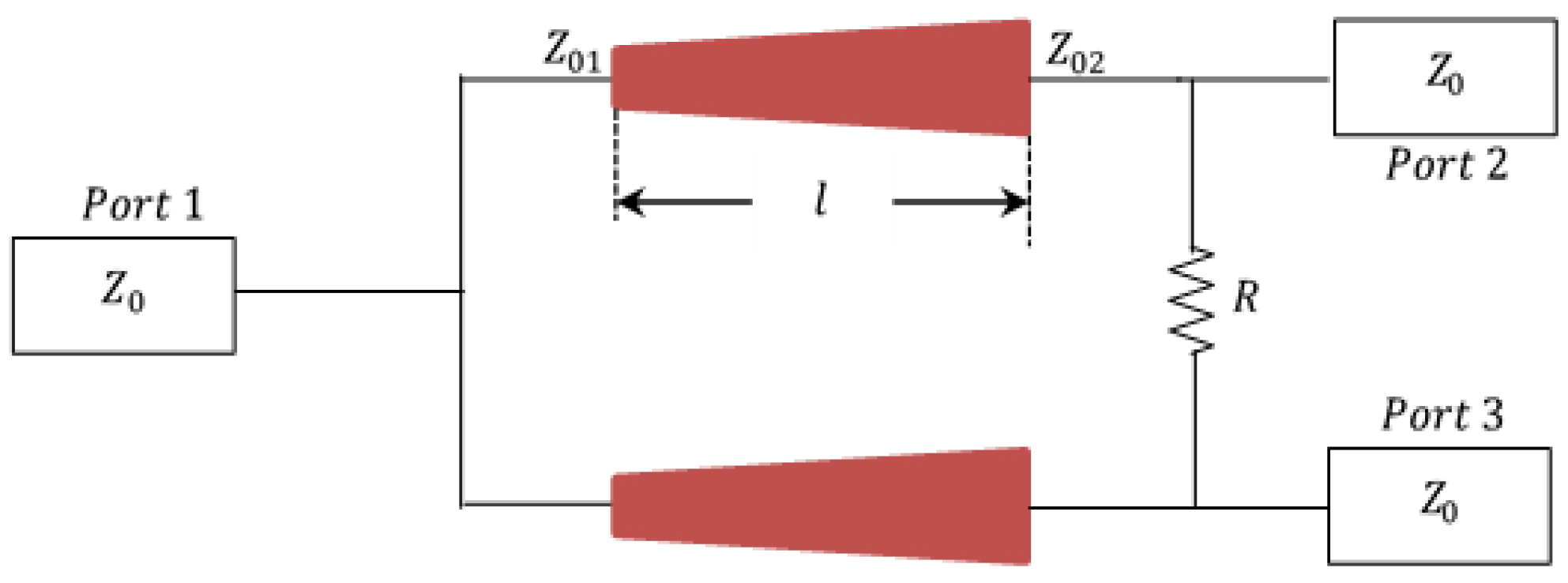
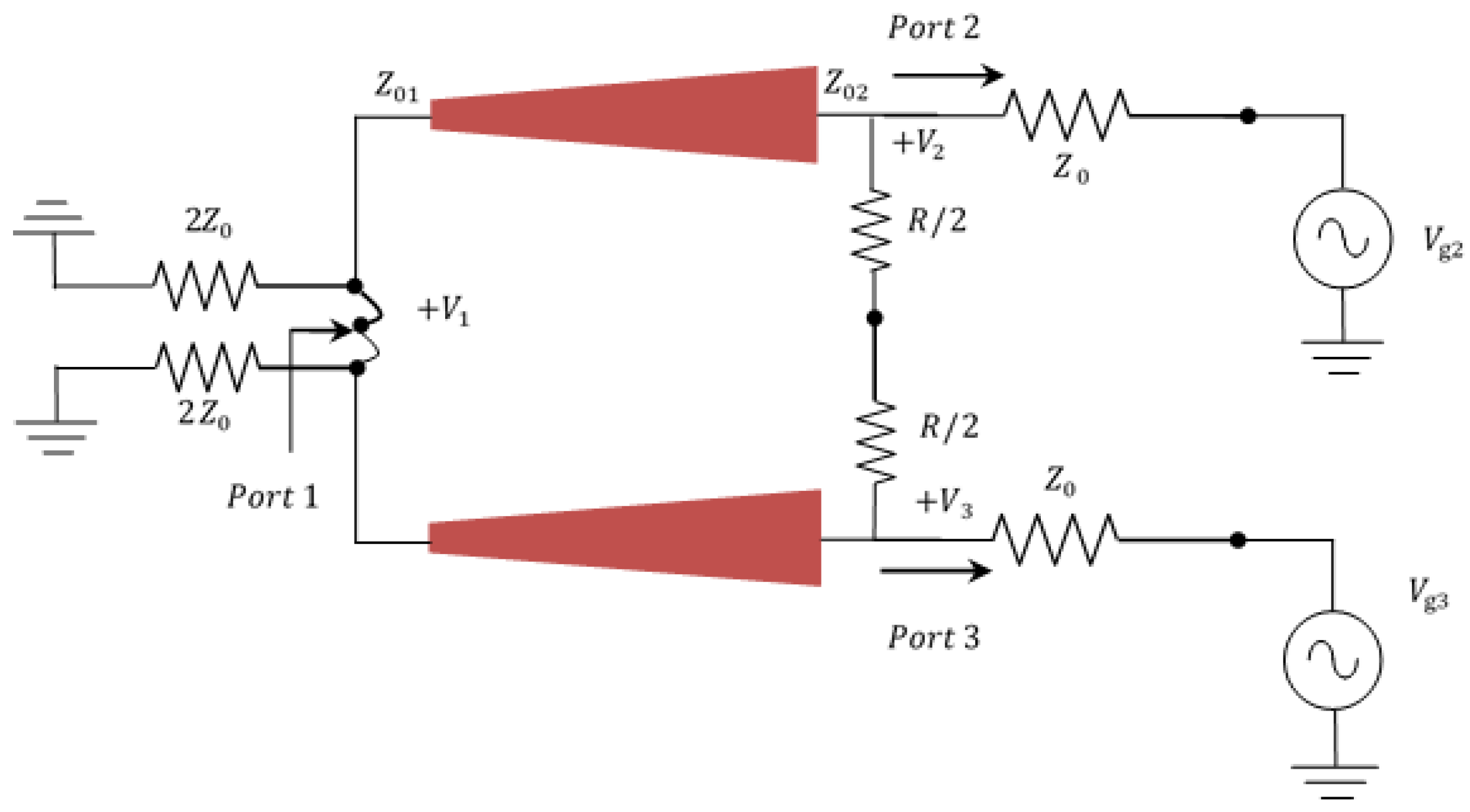

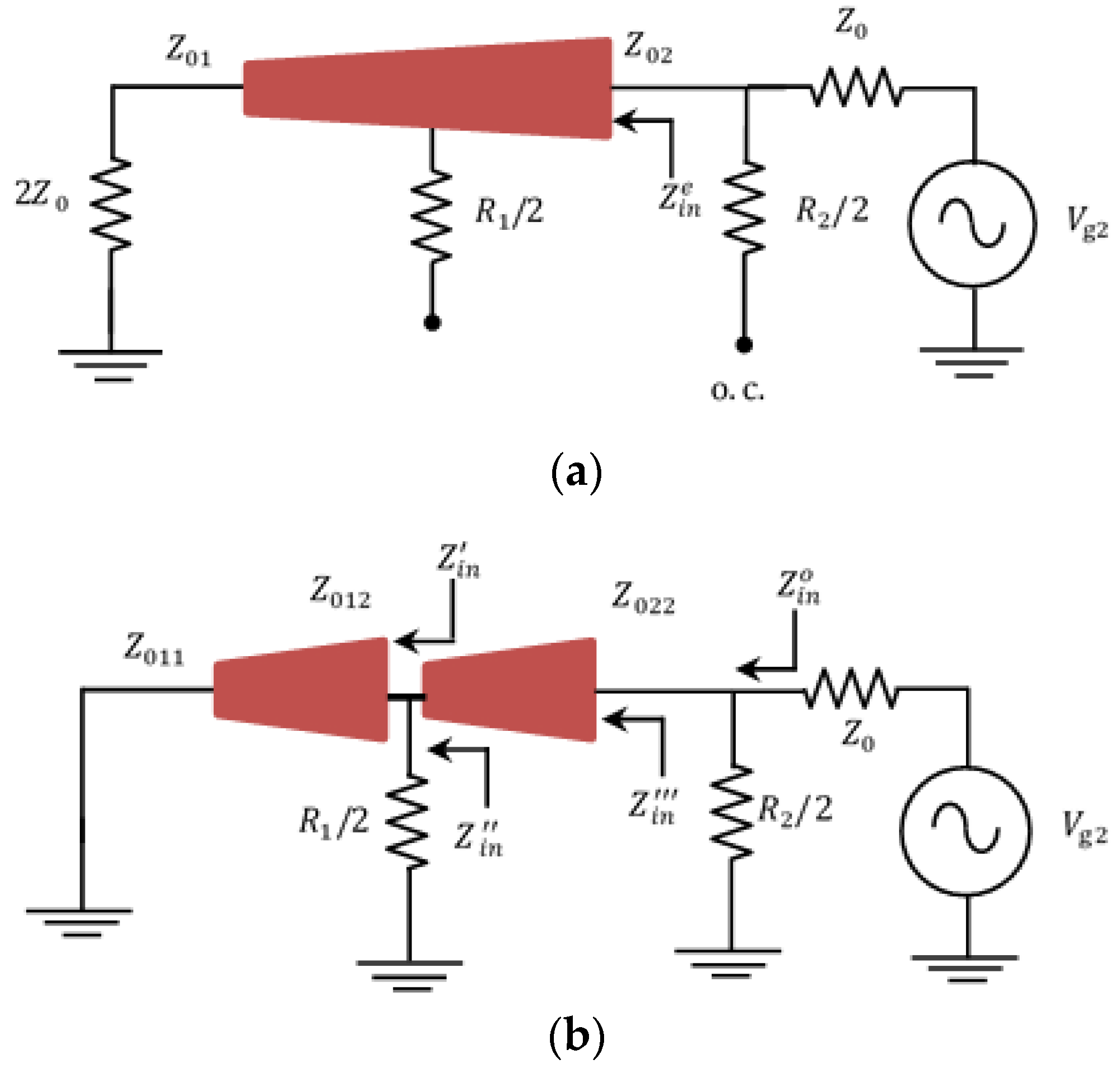

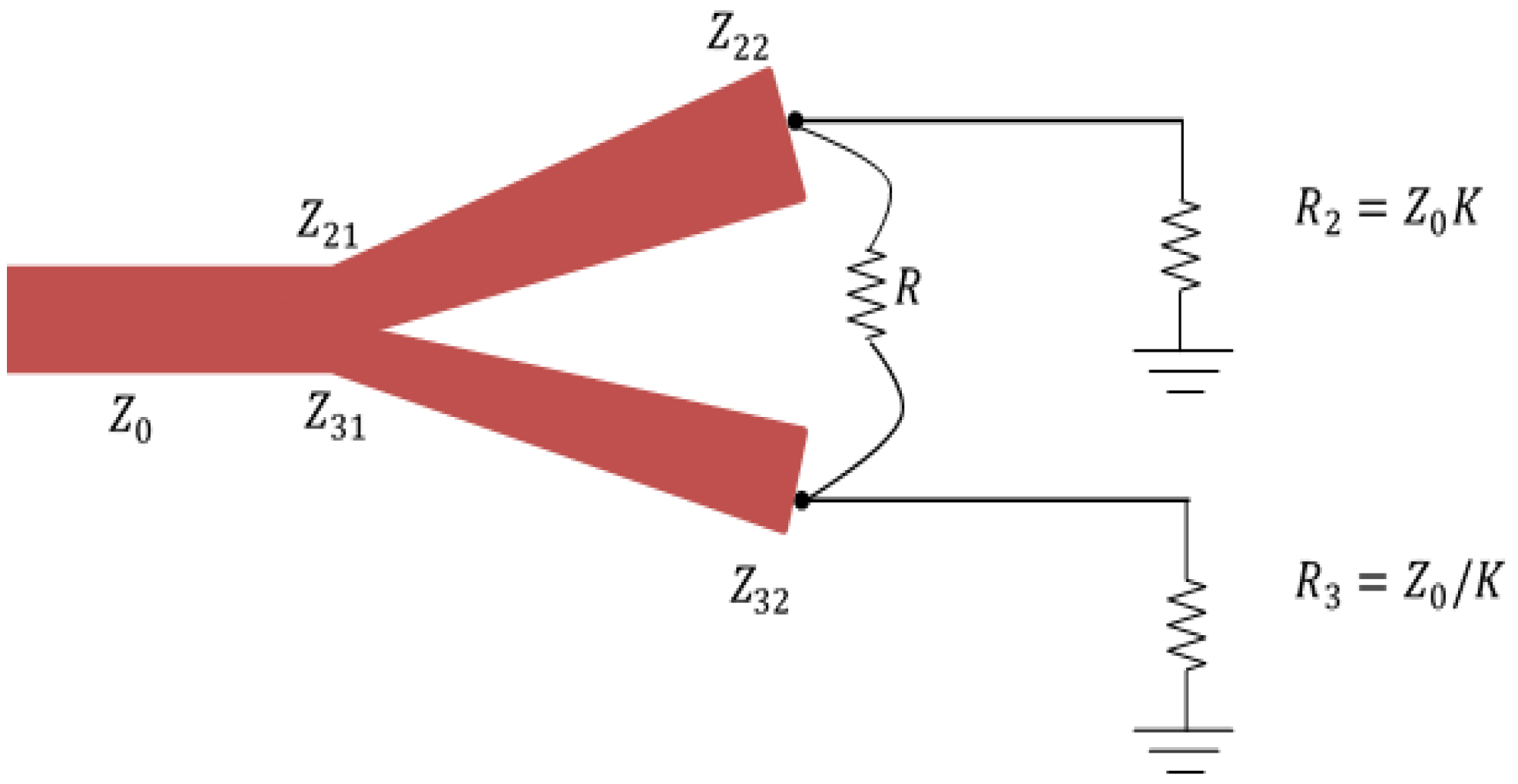

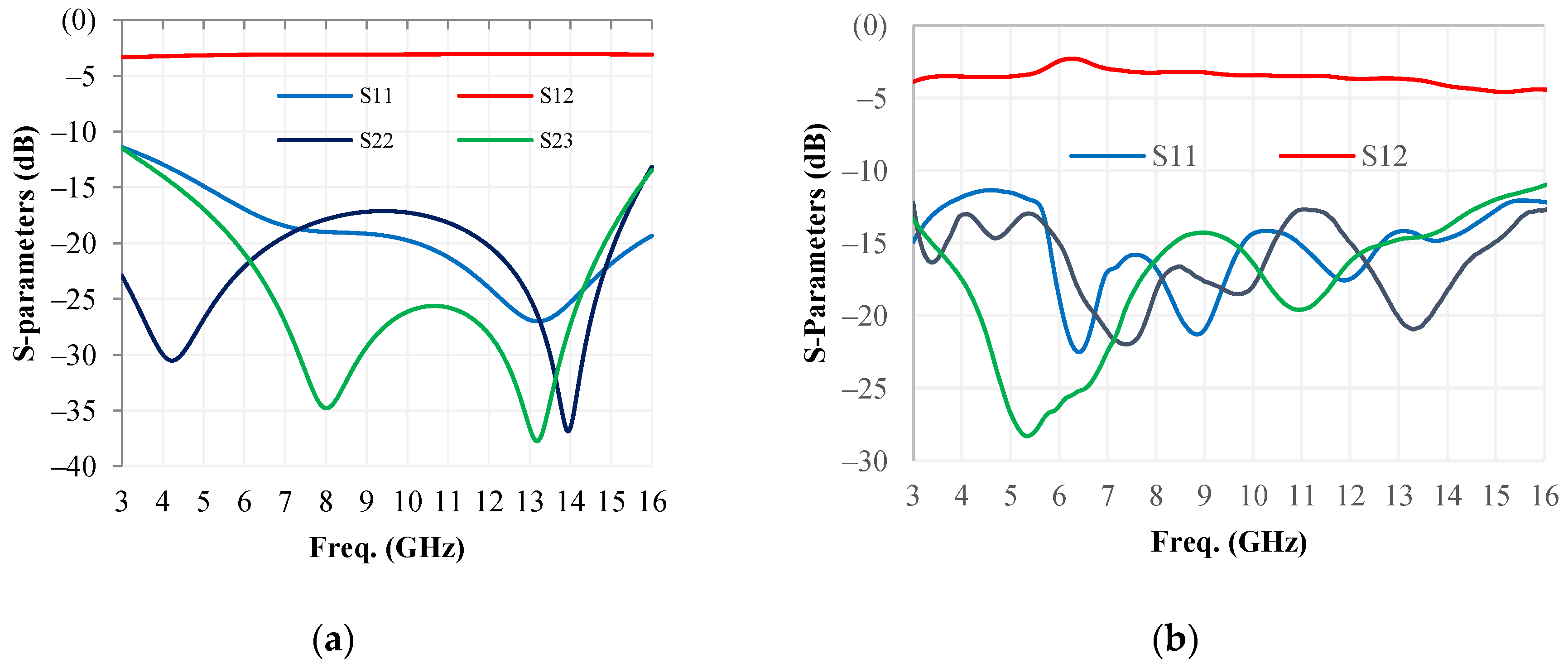
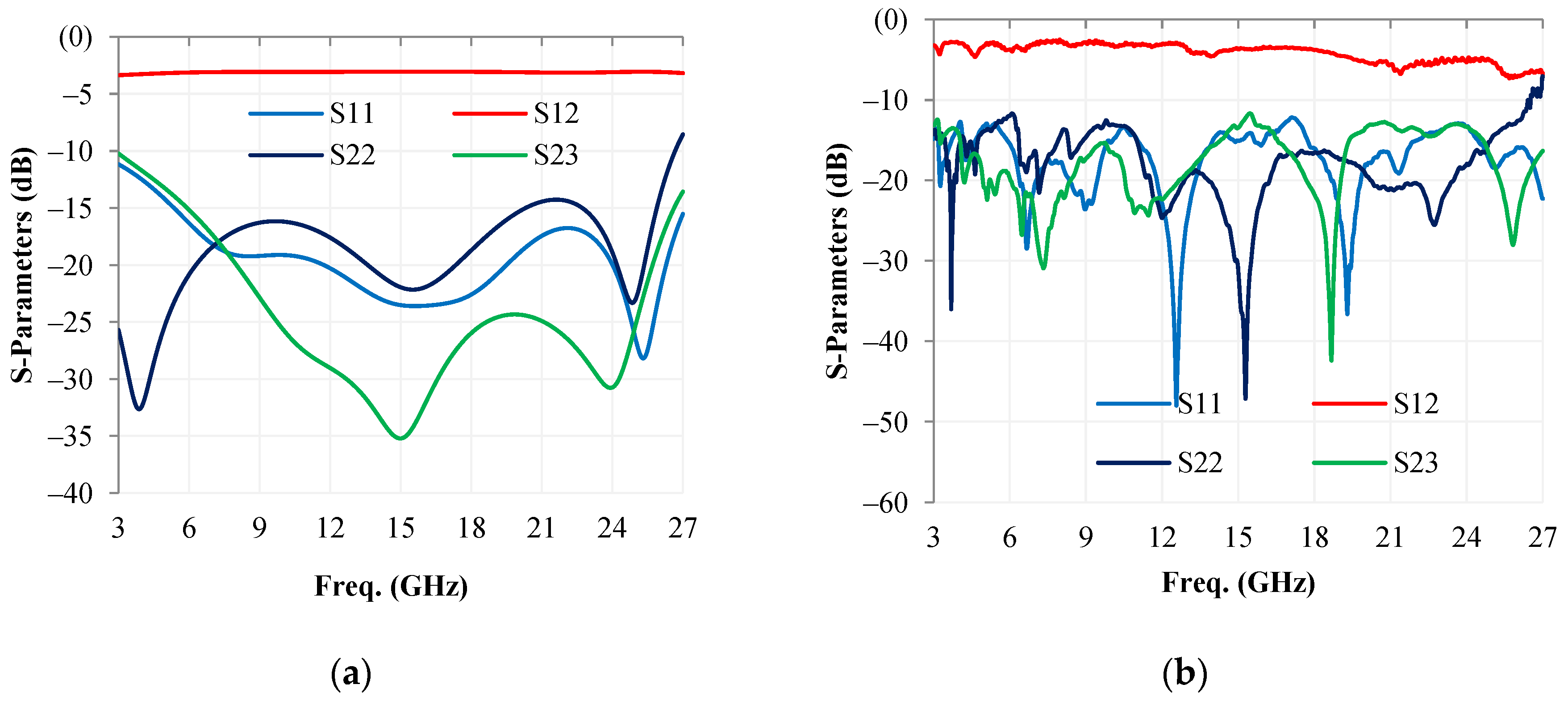
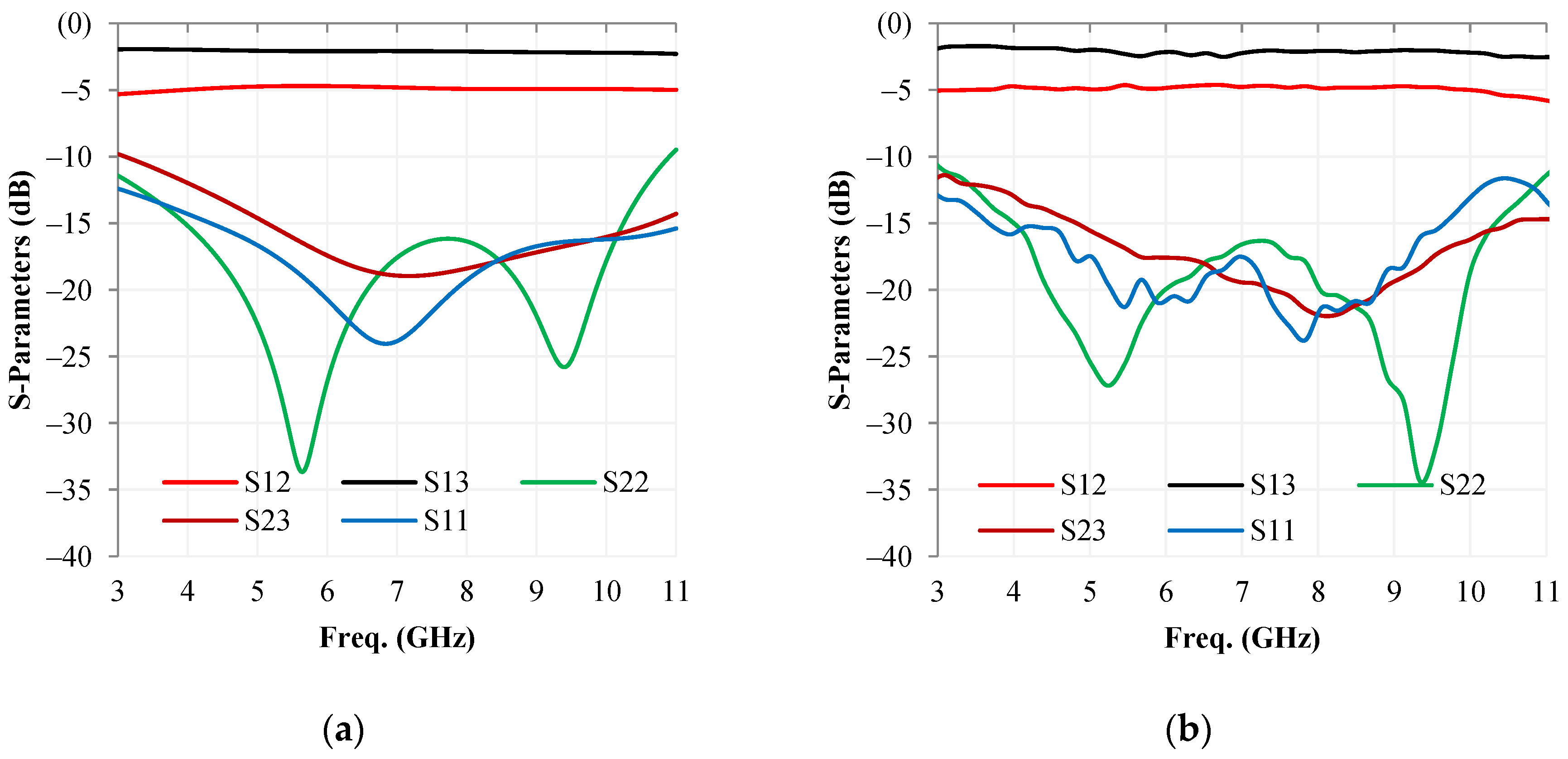
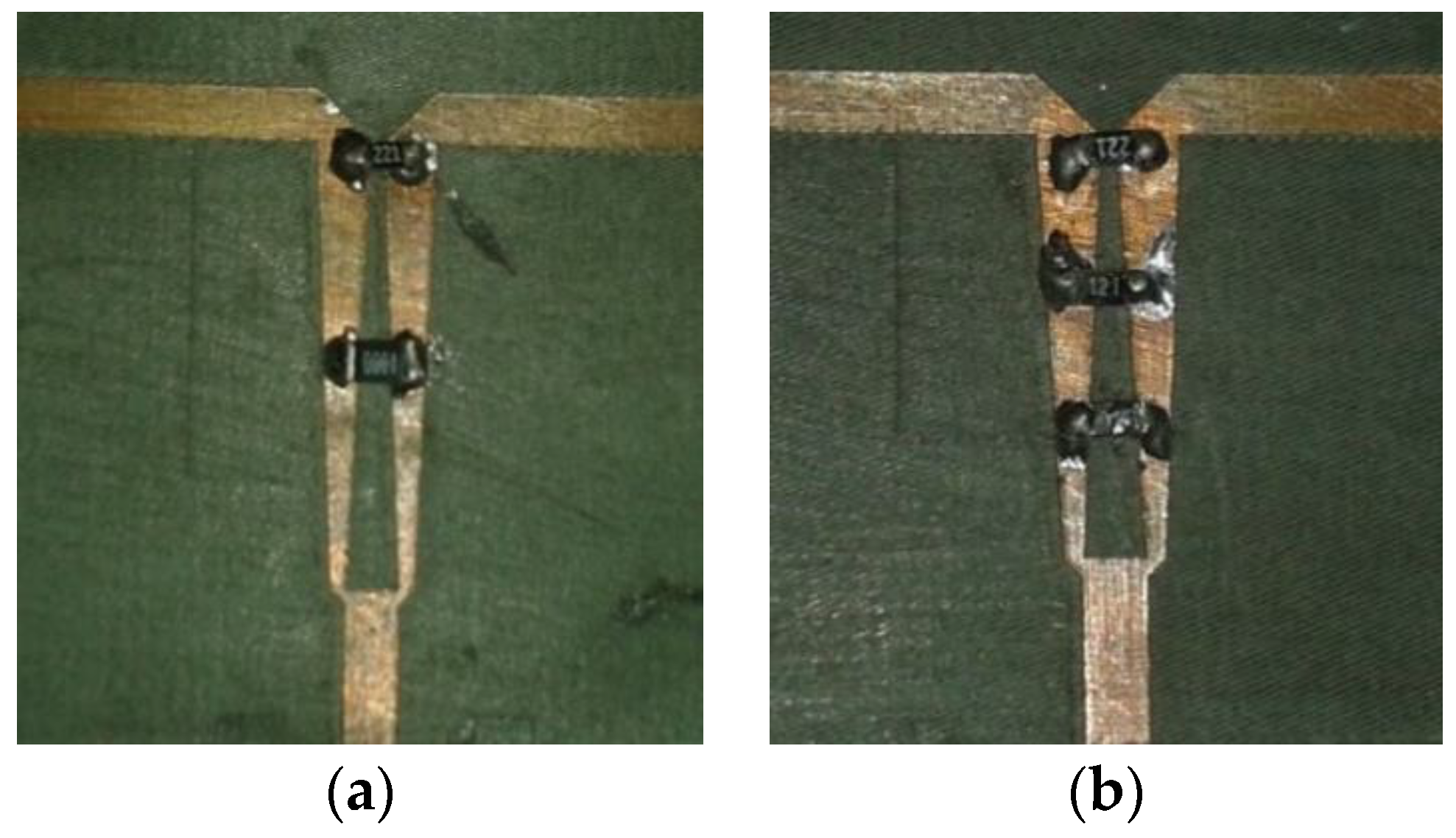
| WPD with One-Isolation Resistor | WPD with Two-Isolation Resistors | WPD with Three-Isolation Resistors | ||||
|---|---|---|---|---|---|---|
| Simulation | Measurements | Simulation | Measurements | Simulation | Measurements | |
| Insertion loss (dB) | ||||||
| Return loss (input) (dB) | ||||||
| Return loss (output) (dB) | ||||||
| Isolation (dB) | ||||||
| Reference | No. of Isolation Resistors | Bandwidth (GHz) | Input Return Loss (dB) | Output Return Loss (dB) | Isolation (dB) | Arm Length (mm) | Techniques |
|---|---|---|---|---|---|---|---|
| [16] | 3 | 3.1–10.6 | 13 | 13 | 10 | 10 | Non-uniform transmission lines |
| [23] | 2 | 3.1–11.0 | 12 | 15 | 12 | 11 | TTLs |
| [24] | 2 | 2.5–10.6 | 15 | 15 | 15 | 18 | Exponential and elliptical TTL |
| [25] | 1 | 3.1–10.6 | 10.3 | 14.4 | 10.1 | 11.6 | Short-ended stub with the open-ended line |
| [18] | 1 | 2.1–11.7 | 10 | Not given | 10 | 15.1 | Square ring multiple-mode resonator |
| [26] | 2 | 3.1–10.6 | 10 | 14.5 | 13.5 | 13.43 | Multi-section transmission lines |
| This work | 1 | 3.1–10.6 | 11 | 11 | 11 | 8.3 | LTTLs |
| 2 | 3.0–16.0 | 12 | 12 | 12 | 9.5 | ||
| 3 | 3.0–27.0 | 11 | 11 | 10 | 9.6 |
Publisher’s Note: MDPI stays neutral with regard to jurisdictional claims in published maps and institutional affiliations. |
© 2022 by the authors. Licensee MDPI, Basel, Switzerland. This article is an open access article distributed under the terms and conditions of the Creative Commons Attribution (CC BY) license (https://creativecommons.org/licenses/by/4.0/).
Share and Cite
Razzaz, F.; Saeed, S.M.; Alkanhal, M.A.S. Compact Ultra-Wideband Wilkinson Power Dividers Using Linearly Tapered Transmission Lines. Electronics 2022, 11, 3080. https://doi.org/10.3390/electronics11193080
Razzaz F, Saeed SM, Alkanhal MAS. Compact Ultra-Wideband Wilkinson Power Dividers Using Linearly Tapered Transmission Lines. Electronics. 2022; 11(19):3080. https://doi.org/10.3390/electronics11193080
Chicago/Turabian StyleRazzaz, Faroq, Saud M. Saeed, and Majeed A. S. Alkanhal. 2022. "Compact Ultra-Wideband Wilkinson Power Dividers Using Linearly Tapered Transmission Lines" Electronics 11, no. 19: 3080. https://doi.org/10.3390/electronics11193080
APA StyleRazzaz, F., Saeed, S. M., & Alkanhal, M. A. S. (2022). Compact Ultra-Wideband Wilkinson Power Dividers Using Linearly Tapered Transmission Lines. Electronics, 11(19), 3080. https://doi.org/10.3390/electronics11193080






